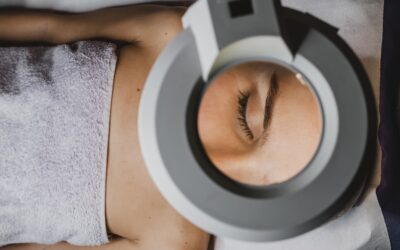Laser hair removal is one of the most popular cosmetic treatments worldwide, but Laser Hair Removal Results can vary significantly depending on your unique combination of skin tone and hair color. While safety considerations for darker skin tones are well-known, there’s much more to understand about how different hair and skin types respond to laser treatments and what you can realistically expect.
Understanding How Laser Hair Removal Works
Laser hair removal works by targeting melanin, the pigment in the follicle that gives hair its color. The two main types of melanin in hair are:
- Eumelanin – produces brown and black colors
- Pheomelanin – produces red and yellow colors
The laser energy is absorbed by the melanin in the hair follicle, which converts to heat and destroys the follicle’s ability to produce new hair. This process, called selective photothermolysis, is most effective when there’s a strong contrast between light skin and dark hair, but some lasers (Alexandrite laser) are able to accomplish this in lighter hair colors that others cannot.
However, this basic principle creates challenges for certain hair and skin combinations that many people don’t fully understand when they begin their laser hair removal journey.
Results for Different Hair Colors and Types
Dark Hair on Light to Medium Skin
People with dark brown or black hair (containing Eumelanin) and lighter skin tones typically see the best results from laser hair removal with most lasers. The high contrast between skin and hair allows the laser to target the hair follicles effectively while minimizing damage to surrounding skin tissue. Most clients in this category achieve 80-90% permanent hair reduction after a complete treatment series, which could range anywhere from 5-15 sessions depending on the area of the body and the density of the hair.
Red and Auburn Hair
Red hair contains a different type of melanin called pheomelanin, which doesn’t absorb laser energy as effectively as the eumelanin found in brown and black hair. People with natural red or auburn hair often experience mixed results with laser hair removal. Some darker red hairs may respond well, while lighter or more orange-toned hairs may show minimal improvement.
Fine Blonde and Light Brown Hair
Blonde hair presents unique challenges for laser hair removal because it contains less melanin than darker hair. When blonde hair does contain melanin, it’s primarily pheomelanin (the same type I correctly mentioned for red hair), but in much smaller quantities than what’s found in red hair. This small amount of pheomelanin can give blonde hair slight yellow, golden, or strawberry tints. Very light blonde, strawberry blonde, and white or grey hair often respond poorly to traditional laser treatments. The limited melanin content means the laser has less pigment to target, resulting in inconsistent or minimal results. Alexandrite lasers with the correct settings can treat most blonde hair, just not the very light peach fuzz. Strawberry blonde and white usually cannot be treated with any laser.
Many people with blonde hair become frustrated after several laser sessions with little improvement. The reality is that traditional laser hair removal may only achieve partial permanent hair reduction on very light hair, and some fine blonde hairs may not respond at all. If you are unsure if you are a candidate, look for a clinic with an Alexandrite laser and ask for a small test patch at higher settings (if the skin is pale with no tan whatsoever). If the test patch area is nearly bald for a period of time after the laser session, then this means it will likely be possible to achieve permanent hair removal in that area.
Grey and White Hair
Grey and white hair contains virtually no melanin at all, making it nearly impossible for lasers to target effectively. As we age and hair loses its pigment, laser hair removal becomes significantly less effective. People who had successful laser treatments in their younger years may notice hair regrowth as their remaining follicles produce grey or white hair.
Uniquely Pigmented Hair
Some people have hair with unusual pigmentation patterns or mixed colors within individual strands. This can include hair that appears one color at the root and another at the tip, or hair with varying density of pigment throughout the strand. These unique characteristics can make laser treatment results unpredictable, as different parts of the same hair may respond differently to treatment.
Skin Tone Considerations Beyond Safety
While safety for darker skin tones is crucial, it’s equally important to understand how different skin tones affect treatment results. The contrast between skin and hair color plays a major role in determining success rates.
Light Skin Tones
People with very fair skin and dark hair have ideal conditions for laser hair removal. The high contrast allows practitioners to use higher energy settings safely, leading to more effective treatments and faster results.
Medium Skin Tones
Medium skin tones, including olive complexions and light brown skin, can achieve excellent results when treated by experienced practitioners using appropriate laser types (ND Yag only). The key is selecting the right laser wavelength and energy settings to maintain safety while achieving effectiveness.
Darker Skin Tones
Darker skin contains more melanin, which can compete with hair follicles for laser energy absorption. This doesn’t mean laser hair removal is impossible for people with darker skin, but it requires specific laser types (ND:Yag only) and careful technique including extra cooling to protect the skin. When done properly, people with darker skin can achieve results comparable to those with lighter skin tones.
Why Alexandrite and Nd:YAG Lasers Lead the Industry
Two laser types have proven to be the safest and most effective for laser hair removal across different skin and hair types: Alexandrite and Nd:YAG lasers.
Alexandrite Lasers: The Gold Standard for Light to Medium Skin
Alexandrite lasers operate at a 755-nanometer wavelength, making them incredibly effective for people with light to medium skin tones and dark hair. This wavelength provides optimal melanin absorption while minimizing damage to surrounding skin tissue. Alexandrite lasers can deliver high energy levels safely, resulting in excellent hair reduction with fewer treatment sessions.
The precision of Alexandrite lasers also makes them ideal for treating large areas quickly, which is why they’re commonly used for legs, backs, and other extensive treatment areas. Most people see significant hair reduction after just 4-6 sessions with Alexandrite lasers.
Nd:YAG Lasers: Safe and Effective for All Skin Tones
Nd:YAG lasers use a longer wavelength of 1064 nanometers, which penetrates deeper into the skin while being less absorbed by melanin in the epidermis. This makes them the safest choice for people with darker skin tones, as the risk of skin discoloration or burning is significantly reduced.
While Nd:YAG lasers may require more treatment sessions than Alexandrite lasers, they provide consistent, safe results across all skin types. They’re particularly valuable for treating people with darker skin who may not be good candidates for other laser types.
Why These Lasers Outperform Others
Both Alexandrite and Nd:YAG lasers have been extensively studied and refined over decades of use. They offer several advantages over older laser technologies and intense pulsed light (IPL) systems:
Superior depth penetration ensures the laser energy reaches hair follicles effectively. Precise wavelengths (depths of reach) target melanin in hair while minimizing impact on surrounding skin. Advanced cooling systems protect the skin surface during treatment. Consistent energy delivery provides predictable results across treatment sessions.
These features make Alexandrite and Nd:YAG lasers the preferred choice for professional laser hair removal practices worldwide.
Alternative and Supplemental Treatments for Challenging Hair Types
When laser hair removal alone isn’t sufficient, several alternative and supplemental treatments can help achieve your desired results.
Electrolysis: The Ultimate Solution for Grey, White, Red or Tattoo’s
Electrolysis works on all hair colors and skin types. Unlike laser treatments, electrolysis doesn’t rely on pigment to destroy hair follicles. Instead, it uses electrical current to permanently damage the follicle’s ability to produce hair. The downside is that it treats each individual hair at a time, making it an incredibly slow process. It can also create tiny scabs on each hair follicle, requiring some healing time after each session.
For people with blonde, grey, white, or red hair who haven’t seen results with laser treatments, electrolysis offers a reliable solution. While electrolysis takes longer than laser hair removal and treats one hair at a time, it can achieve complete permanent hair removal regardless of hair or skin color or hair growing over tattooed skin.
Combination Therapy Approaches
Many experienced practitioners recommend combination approaches for optimal results. This might include starting with laser hair removal to address the majority of pigmented hair, followed by electrolysis sessions to target remaining light or resistant hairs. Some people also combine laser treatments with topical hair growth inhibitors to enhance and maintain results.
Setting Realistic Expectations
Understanding what to expect from laser hair removal based on your specific hair and skin combination is crucial for satisfaction with your results. Here’s what different types can typically expect:
People with dark (brown or black) hair can expect 85-98% permanent hair reduction with a complete laser treatment series. Those with fine or light blonde hair may only achieve 60-90% reduction with laser alone, requiring supplemental treatments for optimal results. People with very light blonde, red, grey, or white hair should consider electrolysis as their primary treatment method, potentially using laser for any darker hairs present.
Conclusion
Laser hair removal can be highly effective across many different skin and hair types, but success depends on understanding how your unique characteristics influence treatment outcomes. While Alexandrite and Nd:YAG lasers offer the safest and most effective options for most people, those with challenging hair colors may need to consider alternative treatments like electrolysis for optimal results.
FAQ
Does laser hair removal work on blonde or red hair in Calgary?
Traditional laser hair removal works best on dark hair (brown or black) because the laser targets melanin pigment in the hair follicle. However, at Elysian Laser Aesthetics in Calgary, we use advanced laser technology (Quanta Alexandrite laser) that can treat blonde, red, and light brown hair more effectively than older systems. That said, very light blonde, white, or grey hair still poses challenges because these lack sufficient melanin for the laser to target. For our Calgary clients with lighter hair colors, we assess candidacy during a free consultation at our Mahogany clinic—some lighter hair will respond well to treatment, while very pale blonde or red hair may see limited results. If you have mixed hair colors (some dark, some light), we can successfully treat the darker hairs while lighter ones may remain. We’re always honest about expected outcomes rather than taking your money for treatments that won’t work. We are always happy to perform test spots or a free, small area session so that you can see if the laser will work for your hair before making a commitment.
Can I get laser hair removal on dark skin in Calgary?
Yes! At Elysian Laser Aesthetics in Calgary, we safely perform laser hair removal on darker skin tones (Fitzpatrick skin types IV-VI) using specialized laser technology called ND:Yag. Older lasers couldn’t differentiate between melanin in dark skin versus melanin in hair follicles, often causing burns and complications. Our advanced medical-grade lasers use longer wavelengths and precise settings that target hair follicles while protecting darker skin. Many Calgary clients with South Asian, Black, Hispanic, and Middle Eastern skin tones successfully achieve safe, permanent hair reduction at our Mahogany location. The key is working with an experienced technician who understands how to adjust laser settings for darker skin and use extra cooling to keep darker skin safe from the heat—this isn’t something to trust to a cheap clinic or inexperienced operator. During your consultation, we’ll assess your specific skin tone and hair type to determine the safest, most effective treatment plan and are always happy to offer laser test spots so you can try the laser before making a commitment. Safety is always our top priority for every client, regardless of skin color.
How many laser hair removal sessions do Calgary clients typically need?
Most clients at Elysian Laser Aesthetics in Calgary need an average 7-12 laser hair removal sessions for permanent hair reduction on areas like Brazilian, underarms, and lower legs. Less hairy areas such as upper legs, forearms, and lower back typically require 4-7 sessions. The number of treatments varies based on several factors: your hair color (dark hair responds faster), hair thickness (coarse hair needs more sessions), hormonal factors (PCOS may require ongoing maintenance), and the body area treated (facial hair often needs more sessions than body hair). At our SE Calgary clinic, we space sessions 6-12 weeks apart depending on the area and hair growth cycle. You’ll notice significant hair reduction after just 3-4 treatments, with progressive improvement after each session. Some Calgary clients need occasional maintenance sessions (1-2 per year) for hormonal areas like chin or upper lip. We create realistic treatment plans based on your individual response rather than selling unnecessary sessions.




